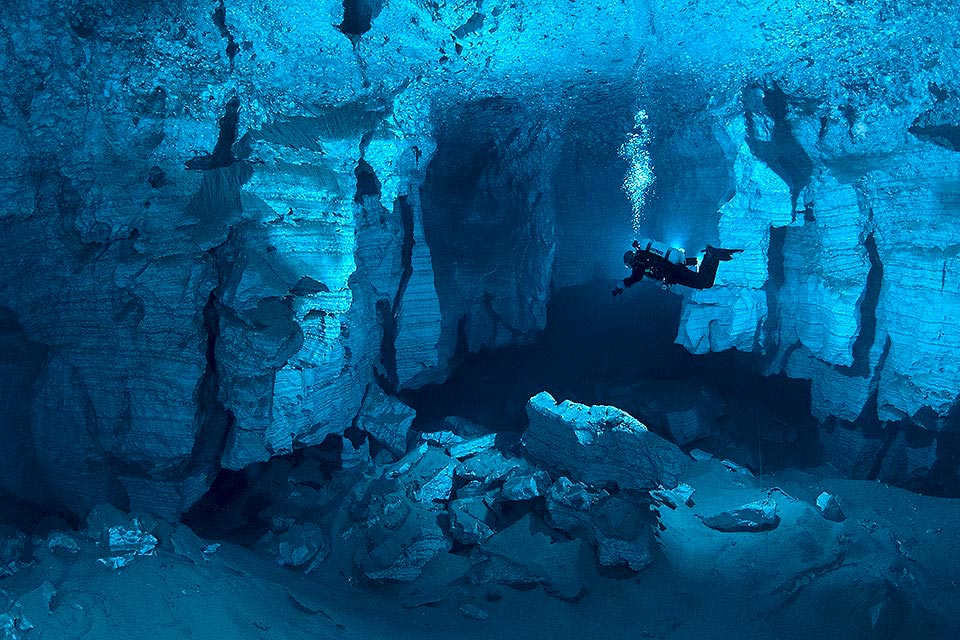
I photographed at the depth of 100 meters. The record depth for a free dive is 300 meters.
I don’t like the theater — in spite of my educational background. I like art, but not the theater. I was lucky (or unlucky) enough to work at the theater just for three months and develop a strong loathing for it. At that time — it was back in the nineties — I was offered a job at The Way to Oneself magazine. It’s a publication with a focus on spiritual development. Ironically, the editor-in-chief was a retired head of a penitential establishment. So his style of work with his employees was kind or penitential too. But I liked the journalistic environment. Then there was The Underwater World magazine. Instead of wages they offered me a diving course, but I agreed. That’s how I started diving.
{ “img”: “/wp-content/uploads/2015/04/lyagushkin01.jpg”, “text”:”” }
{ “img”: “/wp-content/uploads/2015/04/lyagushkin02.jpg”, “text”:”” }
{ “img”: “/wp-content/uploads/2015/04/lyagushkin03.jpg”, “text”:”” }
{ “img”: “/wp-content/uploads/2015/04/lyagushkin041.jpg”, “text”:”” }
What we do is not just underwater photography. There are two directions. The first one is art that we do for ourselves, that is sold in small quantities — those publications are more for self-development. The second direction is popular science, and that is much more in demand because people want to find out about the outside world.
Popular science is in a much higher demand in the West. I next to never get my pictures published in Russian magazines, except for National Geographic Russia. Why do Germans publish stories about Germany, Australia, America and Russia, and Russian magazines never want stories about Russia? I have no idea. I have been looking for the answer to this question for many years already.
This is how things stand here if you take underwater photography: a rich guy buys a tour for divers, takes a picture of a shark, then gives this picture to a magazine for free and feels extremely proud about it. It goes without saying that this scheme is of totally no interest to me as a professional photographer.
I do not so big or expensive stories at my own cost, and afterwards try to make back the production expenses through publications and sales through agencies. There still are topics that might be interesting for sponsors. And there is some art that we do at our own cost — just for art’s sake. We have permanent sponsors supporting our projects — Nikon, Subal, Ikelite.
{ “img”: “/wp-content/uploads/2015/04/lyagushkin05.jpg”, “text”:”” },
{ “img”: “/wp-content/uploads/2015/04/lyagushkin061.jpg”, “text”:”” },
{ “img”: “/wp-content/uploads/2015/04/lyagushkin08.jpg”, “text”:”” },
{ “img”: “/wp-content/uploads/2015/04/lyagushkin09.jpg”, “text”:”” }
Our photo production and photo sales business is similar to saucepan making. We have a marketing department that decides whether this kind of saucepan is going to sell or not. Then we start making them. And it goes without saying that unusual saucepans sell better. That is — saucepans that evoke symbols, saucepans that are original in shape, that are interesting to look at, that reveal to the human kind a new idea of source pans, that have some kind of unusual functions. If we start making the same kind of saucepans as Lysva saucepan factory does, we will soon go bankrupt because it is difficult to compete with a factory. That’s why we make very little, but what we make is very efficient in terms of sales. In four years we have produced 12 stories.
The kind of classic photography I work like is David Doubilet and Wesley C. Skiles.
For a number of years Paul Nicklen was trying to get to the Barents sea, but they didn’t let him. No matter that he managed to have an audience with [the Defence Minister Sergey] Shoygu and the latter promised to make a pass for him. They just didn’t let him. We have a very closed country. In order to do a photo shoot at the Baltic and the Barents sea one needs to have a special pass. Even in order to enter the Black sea one needs a special pass. And they wouldn’t give it to a foreigner. I think that we are still in the USSR — nothing has changed. We just stopped noticing it. Even getting to Russia makes a whole lot of difficulties for a foreigner.
In Russia, with the exception of myself, there are no other professional underwater photographers. It happens that I am the only one, no one else can come here: the whole of Russia with all of its rivers, lakes, seas and oceans is just for me, alone, to shoot.
If you are afraid of the deep or of sea animals, it is better not to try doing this. I have never been afraid.
Shooting underwater, especially in the caves, is like shooting on the Moon. The questions of exposure, aperture and sharpness become less crucial. The most difficult thing is getting to that Moon. The preparation process for such a photo shoot takes up to 90 percent of the time.
I spend four to five months at home. The rest of the time I spend travelling.
There are two of us in my team: my wife Bogdana and me. She assists me and writes articles. But since what we do is quite expensive, for each project we gather a team of friends and volunteers willing to participate.
Let’s suppose you are going to the mountains, or to Everest, how are you going to test stress resistance and preparation of the team? The community of people going to Everest is small — everyone knows everyone there. That’s why there is no question of testing stress resistance and endurance while choosing people for a team. I receive up to three letters a day from total strangers asking me to take them on an expedition. But they mainly ask to be either cleaners or carriers or dishwashers. They are not trying to do the real work.
{ “img”: “/wp-content/uploads/2015/04/lyagushkin121.jpg”, “text”:”” },
{ “img”: “/wp-content/uploads/2015/04/lyagushkin131.jpg”, “text”:”” },
{ “img”: “/wp-content/uploads/2015/04/lyagushkin141.jpg”, “text”:”” },
{ “img”: “/wp-content/uploads/2015/04/lyagushkin151.jpg”, “text”:”” }
Equipment can fail at any moment — in any conditions. Yesterday my camera got jammed at home. In my apartment. And Cameron dived into the Mariana Trench — and his camera got jammed there. Anything is possible.
“The Mistress of the Horde” was really difficult. It was the first staged shooting done in a cave as a free dive. Which means, if something went wrong, there would be a dead body. And since there have already been lethal accidents on our expeditions that project was very risky. Natasha (the model: editor’s note) had belayers who swam up to her with a ballon so she could breathe. She was unable to swim because she was bound to the place with ropes, so if, for example, the visibility were to decrease, the belayer wouldn’t be able to find her. The water temperature was 5 degrees. Those were really extreme conditions.
There are a lot of risks in what we do. It is like Russian Roulette: you have a cylinder with just one round in it for 300 slots, but if you pull the trigger every day, one day it’s gonna get you, no matter how lucky you are.
I am an artist. A porridge is boiling in my head. There are bubbles on its surface, those bubbles generate all kinds of things. And those generated things are innumerable. And it is fun to observe as those imaginary things become real. That driving force makes me carry the gallons, run around, make phone calls, organise everything and try to do something.
It goes without saying that I keep an eye on more photographers than just those doing underwater shoots. I must admit that there is a big problem with underwater photography – it is based on its own Moon. We are all there and nothing other than that is of interest to us. In the whole world underwater photography is self-sufficient, so to say. But I have a dream — I would like to try dragging other kinds of photography underwater. Try to find some correlations.
{ “img”: “/wp-content/uploads/2015/04/lyagushkin111.jpg”, “text”:”” }
{ “img”: “/wp-content/uploads/2015/04/lyagushkin101.jpg”, “text”:”” }
{ “img”: “/wp-content/uploads/2015/04/lyagushkin171.jpg”, “text”:”” }
{ “img”: “/wp-content/uploads/2015/04/lyagushkin18.jpg”, “text”:”” }
Underwater photography changes much slower than other kinds of photography because people who shoot underwater are so few. And those doing something worthwhile underwater are even fewer. Maybe around one hundred people in the whole world. Considering photography in general and its history, our underwater photography is somewhere in the 1920s.
We’ve got two books out. One of them, The Orda Cave: The Cognition, is dedicated to the world’s longest gypsum cave filled with water. And last year we made a book about dolphins. It’s titled To Be a Dolphin. I like them both. But making a book is a great joy on the one hand, and a big nuisance on the other. You need to think of what to do with those printed copies, go to shops, sign contracts, raise money. But now we have found an ideal format – iBook. So our third book is already in that format. It is 170 photographs and 100 facts about dolphins. You open a full-screen photo on your iPad, you touch it, and there is a short text. All the previous generations of photographers dreamed about this format. Ordinary photo albums are usually very bulky, but if you “season” images with a short story, it makes a great book.
{ “img”: “/wp-content/uploads/2015/04/lyagushkin19.jpg”, “text”:”” }
I am inspired by my wife. I don’t turn to other photographers for inspiration. I can already make an assessment of the best photographers working on my field. I understand everything about them – what they did and what for – and that doesn’t thrill me. I am more thrilled by the works in the genres that I know little about.
My dream is to shoot Krubera-Voronja, the deepest cave in the world. So far no one has managed to photograph it. National Geographic once sent an expedition there: they spent $50,000, but didn’t shoot anything. It’s really hard to be there.
If I was offered to go into space and shoot there, I would agree without thinking.





